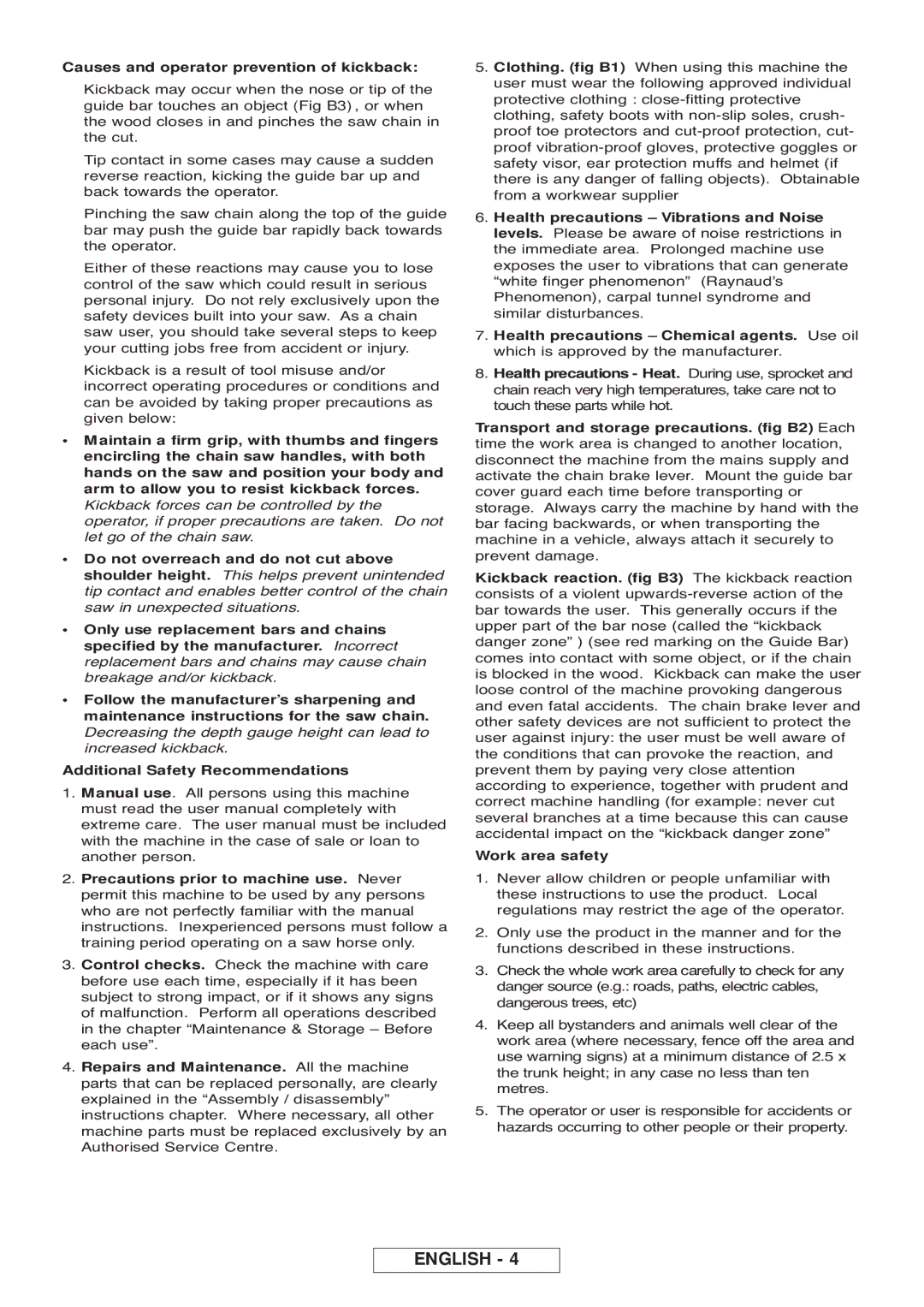Causes and operator prevention of kickback:
Kickback may occur when the nose or tip of the guide bar touches an object (Fig B3), or when the wood closes in and pinches the saw chain in the cut.
Tip contact in some cases may cause a sudden reverse reaction, kicking the guide bar up and back towards the operator.
Pinching the saw chain along the top of the guide bar may push the guide bar rapidly back towards the operator.
Either of these reactions may cause you to lose control of the saw which could result in serious personal injury. Do not rely exclusively upon the safety devices built into your saw. As a chain saw user, you should take several steps to keep your cutting jobs free from accident or injury.
Kickback is a result of tool misuse and/or incorrect operating procedures or conditions and can be avoided by taking proper precautions as given below:
•Maintain a firm grip, with thumbs and fingers encircling the chain saw handles, with both hands on the saw and position your body and arm to allow you to resist kickback forces.
Kickback forces can be controlled by the operator, if proper precautions are taken. Do not let go of the chain saw.
•Do not overreach and do not cut above shoulder height. This helps prevent unintended tip contact and enables better control of the chain saw in unexpected situations.
•Only use replacement bars and chains specified by the manufacturer. Incorrect replacement bars and chains may cause chain breakage and/or kickback.
•Follow the manufacturer’s sharpening and maintenance instructions for the saw chain.
Decreasing the depth gauge height can lead to increased kickback.
Additional Safety Recommendations
1.Manual use. All persons using this machine must read the user manual completely with extreme care. The user manual must be included with the machine in the case of sale or loan to another person.
2.Precautions prior to machine use. Never permit this machine to be used by any persons who are not perfectly familiar with the manual instructions. Inexperienced persons must follow a training period operating on a saw horse only.
3.Control checks. Check the machine with care before use each time, especially if it has been subject to strong impact, or if it shows any signs of malfunction. Perform all operations described in the chapter “Maintenance & Storage – Before each use”.
4.Repairs and Maintenance. All the machine parts that can be replaced personally, are clearly explained in the “Assembly / disassembly” instructions chapter. Where necessary, all other machine parts must be replaced exclusively by an Authorised Service Centre.
5.Clothing. (fig B1) When using this machine the user must wear the following approved individual protective clothing : close-fitting protective clothing, safety boots with non-slip soles, crush- proof toe protectors and cut-proof protection, cut- proof vibration-proof gloves, protective goggles or safety visor, ear protection muffs and helmet (if there is any danger of falling objects). Obtainable from a workwear supplier
6.Health precautions – Vibrations and Noise levels. Please be aware of noise restrictions in the immediate area. Prolonged machine use exposes the user to vibrations that can generate “white finger phenomenon” (Raynaudʼs Phenomenon), carpal tunnel syndrome and similar disturbances.
7.Health precautions – Chemical agents. Use oil which is approved by the manufacturer.
8.Health precautions - Heat. During use, sprocket and chain reach very high temperatures, take care not to touch these parts while hot.
Transport and storage precautions. (fig B2) Each time the work area is changed to another location, disconnect the machine from the mains supply and activate the chain brake lever. Mount the guide bar cover guard each time before transporting or storage. Always carry the machine by hand with the bar facing backwards, or when transporting the machine in a vehicle, always attach it securely to prevent damage.
Kickback reaction. (fig B3) The kickback reaction consists of a violent upwards-reverse action of the bar towards the user. This generally occurs if the upper part of the bar nose (called the “kickback danger zone” ) (see red marking on the Guide Bar) comes into contact with some object, or if the chain is blocked in the wood. Kickback can make the user loose control of the machine provoking dangerous and even fatal accidents. The chain brake lever and other safety devices are not sufficient to protect the user against injury: the user must be well aware of the conditions that can provoke the reaction, and prevent them by paying very close attention according to experience, together with prudent and correct machine handling (for example: never cut several branches at a time because this can cause accidental impact on the “kickback danger zone”
Work area safety
1.Never allow children or people unfamiliar with these instructions to use the product. Local regulations may restrict the age of the operator.
2.Only use the product in the manner and for the functions described in these instructions.
3.Check the whole work area carefully to check for any danger source (e.g.: roads, paths, electric cables, dangerous trees, etc)
4.Keep all bystanders and animals well clear of the work area (where necessary, fence off the area and use warning signs) at a minimum distance of 2.5 x the trunk height; in any case no less than ten metres.
5.The operator or user is responsible for accidents or hazards occurring to other people or their property.
